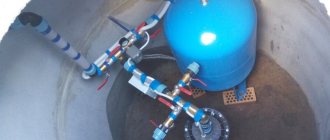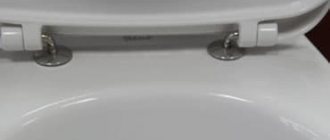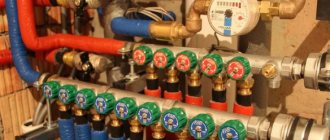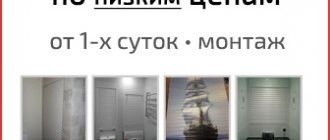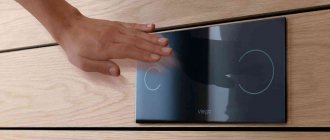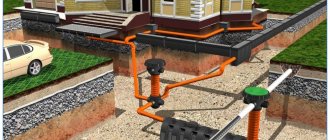Storm drainage is necessary for drainage of melt water and precipitation.
Installed on highways, squares, and the private sector. In public places, storm drains with storm drain grates are used. This element performs not only a decorative function. The grille protects against possible injuries and filters out large debris. If the city administration has no questions about the choice of gratings, then the owner of the house, installing a storm drain, may well be puzzled by the choice.
Let's look at what manufacturers offer.
Why do you need a drainage system?
The main function of protecting a house from precipitation is performed by the roof. The overhangs of the slopes extending beyond the line of the facades divert water coming from the roof to a certain distance from the building. But even with very wide overhangs, the water draining from the roof ends up too close to the outer walls and if it is not removed using a drainage system, it will wash away the foundation and base of the building.
The walls of the house can also be damaged by water flows passing through the site and passing along the building. This phenomenon is typical for areas with a slope. With the help of storm ditches, water flows are redirected to the sewer system or off site. Drainage is also needed to protect the surface of paths and areas on the site. For example, if water stagnates on a recreation area lined with a terrace board, the coating will very quickly fail.
Storm grate along the lawn Source zen.yandex.ru
Installation rules
Before installing the grille, the tray itself must be properly mounted. The installation procedure depends on the material from which it is made.
Plastic trays
Installation of polymer structures is carried out in stages:
- A ditch is dug in accordance with the drawing in the area where the tray product is supposed to be installed.
- A concrete base is created by pouring the solution in an even layer onto the bottom of the ditch.
- Plastic trays are placed in the trench in the center.
- The slopes are filled with concrete to ensure the stability of the drainage structure.
The trays are connected end-to-end into a single structure. For convenience, there is a tongue on one side of the tray, and a groove on the opposite side. For a corner connection, cut a small hole in the side wall and join the products at an angle of 90 degrees, seal them and install a plug.
Fix the grille on the plastic tray as follows:
- Install the main fastening system in the tray element by unscrewing the bolt from it.
- Fasten the hardware into the groove on the lattice part.
- Tighten the screw - firmly, until it stops.
The stamped grille is fixed quite simply: bend the locks along the edges and secure the part in the tray.
Types of drainage system
The drainage system can be open or closed. The second option is more complex, but also more convenient. Storm ditches protected by gratings are not dangerous like open trenches, but they fit better into the landscape design of the site and allow you to freely design the local area.
Closed drainage can be point or linear. When arranging point drainage, wells are installed in places where water accumulates on the site. The underground drainage structure is quite complex and includes a whole set of elements, such as a sand cushion, a concrete layer, drainage trays, sewer pipes and other components. From above, this entire structure is covered with a drainage grid.
An example of arranging point drainage for a site Source pinterest.com
When creating a linear drainage system, a trench with trays is pulled along the line of water accumulation. The underground part of the structure is similar to the point part, but has a slight recess. All trenches (gutters) laid on the site discharge water into a storm sewer or into a general drainage well. The entire length of the gutters is covered with gratings.
Purpose of drainage gratings
Stormwater gutters with gratings
Stormwater and drainage can be arranged using drainage gutters to drain excess moisture. For their manufacture, concrete, metal and polymers with a smooth surface are used. When installing tray structures at an angle, a uniform drainage of excess water is ensured even after prolonged downpours. The devices are covered with special grilles that can prevent branches, leaves and other debris from getting into the sewer.
Lattice parts also have additional functions:
- Safety. By closing the drainage cavity, they help avoid injuries to people and animals due to carelessness.
- Creating unimpeded passage for transport. Drainage gratings laid flush with the road surface allow vehicles to maneuver and withstand significant loads.
- Landscaping of the territory - street or garden plot.
In appearance, the drainage grid for draining wastewater on the street can be slotted or cellular. Both types are functional; the choice is determined by decorative preferences.
Selecting a drainage grid
The entire drainage system must be properly designed and efficiently equipped. All elements are important in it, without exception. However, the only visible part of it is a set of gratings that cover gutters and wells. This means that the grille must not only be reliable and durable, but also quite aesthetically pleasing. Although drainage trenches are usually laid along paths, the grates will often be stepped on, and therefore they must be durable and non-slippery.
Anti-slip grille Source 4geo.ru
A well-chosen grid provides the drainage structure with the required rate of wastewater intake, and at the same time it should not allow large debris into the system that could clog the pipes. There are gratings on sale in different parameters, from different materials and from different manufacturers.
Application of storm grates
When choosing a storm grate, it is necessary to take into account the characteristics of the installation location (pedestrian area, roads or warehouse terminals) and the expected loads - in drainage systems, for each structure subject to static or dynamic loads, it is customary to assign a certain load class. For drainage trays and storm grates in Russia, six such classes are used, with the designations: A15, B125, C250, D400, E600, F900, according to the European standard DIN 19580 or EN 1433. The load class is measured by the force value (kN), where 1 kN = 100 kg* m/s².
Only cast iron grates are reliable for maximum loads!
Load classes
Each storm grate in our product catalog is presented with an indication of its technical features, dimensions and scope of application!
Load classification
When choosing a grating option for arranging a site, you need to take into account their cost, durability and external characteristics. But the most important thing is to correctly determine the strength of products.
Based on load, products are divided into 6 classes - A, B, C, D, E, and F. The stronger the grating, the more expensive it is. Naturally, there is no point in installing structures designed for industrial zones or, for example, parking lots, on the territory of a private household. Class A gratings can withstand minimal loads. They are ideal for landscaping the pedestrian part of the yard. Where vehicles will enter, it is better to install class B products.
Classification of gratings for rain showers Source truba68.ru
Material
Grilles can be made from:
- cast iron;
- become;
- copper;
- plastic.
Each of these materials has its own advantages and disadvantages.
Cast iron
Cast iron is the classic material for storm grates. Not so long ago it was the main material for the design of urban drainage systems. Cast iron protective elements differ in material quality, size and shape. Their main advantage is that they are able to withstand very heavy loads. If trucks or construction equipment often enter the site, cast iron protection for storm gutters will be most suitable.
Cast iron has other advantages. It is resistant to corrosion and sudden temperature changes, and is not susceptible to prolonged frosts. But it also has its drawback - it is heavy. In addition, cast iron drainage grates for gutters do not always look attractive, which is due to the technology of casting cast iron products.
Cast iron grates are usually made of rectangular shape. Square protective elements are produced less frequently. The holes have a standard width, allowing the products to effectively pass wastewater flows.
Cast iron grate for rainwater inlet Source stroy-podskazka.ru
Different types of cast iron are used in the production of gratings. The products themselves are divided into several classes according to the degree of strength. For private households, it is recommended to use products of minimum strength class A15, capable of withstanding loads of up to 1.5 tons. However, if necessary, you can install B125 class gratings that can withstand 12.5 tons. More durable versions of cast iron products are intended for industrial areas.
Types of storm drains on the roof
There are two types of roof storm drainage:
- open (hinged, outdoor);
- internal.
Although both types of storm drains are needed to drain water, their characteristics and uses are radically different.
Open storm system
This is a familiar drainage system that is suspended from the eaves of a pitched roof. Most storm drains are of this type, as rock roofs are much more common than flat roofs.
Advantages and disadvantages
Open roof storm drain:
- easy to install, repair and clean;
- inexpensive;
- light;
- effective;
- can become an organic part of home design;
- elementary in calculation and design for houses with simple roofs;
- installs quickly;
- reliable.
In general, this says it all - with such advantages, the widespread use of open drainage systems should not be surprising. Open storm drains are installed even on the flat roofs of low buildings. In this case, the collection and drainage of water into the gutters occurs through overflow funnels, for installation of which a through hole is made in the parapet. And for pitched roofs, such a storm drain is practically the only possible option.
But not all buildings can use open gutters. For some buildings, hanging storm drainage is not suitable due to a number of disadvantages:
- Limited drainage capacity . As the roof area increases, the throughput of the external drainage system increases significantly more slowly than the volume of rain falling on the roof.
- Cannot be installed on tall buildings . According to SP 118.13330.2012, external organized drainage is permissible only for buildings of five floors or less.
- Relatively high risk of blockage . Once the storm drain on the roof is open, debris, such as leaves and branches, can easily enter it. And in dry times, birds like to build a nest in the drain.
- Increased risk of icicle formation . Even an absolutely correctly made drain in winter can become clogged with frozen lumps of snow. Because of this, meltwater will overflow the edges of the gutter and turn into icicles.
- Risk of being blown away by wind or snow melting in winter . If the installation of storm drainage on the roof is done correctly, this risk is almost zero. But an abnormally strong wind can still tear off even a well-fixed drain.
That is, external storm drainage is usually not suitable for drainage from the roofs of large shopping centers, residential high-rise buildings, and industrial buildings. And the larger the roof area, the less justified is the installation of an open drain. Also, this type of storm drain is not the best option if the building is located on a busy street.
Installation of storm drainage from the roof for external installation
An open roof storm drainage system consists of four main elements:
- gutter into which water flows from the slopes;
- drain funnelthrough which water from the gutter enters the outlet pipe;
- a drainpipe that ends either 250-300 mm above the ground or is connected to the sewer system;
- dead-end plugs that cover the free edges of the gutter.
Other important elements of roof storm drainage include various bends and elbows for designing gutter turns and pipe bypasses. Without them, you can only assemble a very simple drainage system.
Other elements, for example, gratings to protect the drain from debris, are not necessary for installing storm drains from the roof. But they increase its efficiency and reliability.
Internal storm drainage on the roof
An internal drain is a storm drain that is not suspended from the eaves, but is laid inside the building. Unlike an external drain, this is always a storm drain - there are simply no internal systems that discharge collected water onto the sidewalk.
Advantages and disadvantages
The internal storm drainage system of the roof is almost the exact opposite of the external one. A storm drain like this:
- Placed on buildings of any height . If the building has six floors or more, then this is generally the only possible option.
- Doesn't freeze in winter . The pipes are laid inside the building, so there cannot be any ice jams in them.
- Can be of any bandwidth . Drainage funnels can be installed at any meter, and the outlet pipe can be of any diameter, including custom-made ones.
- Protected from extreme weather by the walls of the building . He doesn't care about any wind.
- Greatly reduces the likelihood of icicles appearing on the eaves.
Internal storm drainage is standard for flat roofs, especially large ones. But it is done extremely rarely on houses with a pitched roof. And here are the reasons:
- High price . The need for full-fledged design, expensive materials and extremely complex installation make the internal storm drain on the roof many times more expensive than the external one.
- Difficulty in installation . Stretch a network of pipes through the entire building, cut funnels into the roof, connect the system to the sewer system - this is not hanging a gutter on the eaves.
- The consequences of poor installation or wear are more severe . Internal storm drain leaks are leaks inside the building with all the ensuing consequences.
- Difficulty in maintenance and repair . If the internal storm drain of the roof becomes clogged, then specialized equipment will be needed to clean it.
In addition, according to regulations, internal drainage cannot be laid inside the wall of the house. And on pitched roofs there is simply no place to do it except inside the walls.
These disadvantages completely cover the advantages of internal drainage. Therefore, it is usually done where it is impossible to install an external storm drain.
How does the internal drainage system work?
Internal sewerage is a system of four elements:
- Drainage funnels. They are placed in the recesses of the roof so that they collect water more efficiently.
- Outlet pipes . Channels through which water enters the riser.
- Boner . A vertical pipe that runs through the entire building and connects to a sewer or sewer.
- Inspection hatches . These are parts of the pipe with hatches that are needed to service the system and assess its condition.
Another part of the internal storm drainage can be considered a slope on the roof, since without it the water will not collect at the funnels.
Regulations
Road storm drainage is designed on the basis of SNiP 2.05.02-85 and SP 32.13330.2012. These documents define the tasks and features of drainage on highways, expressways and conventional roads (of all categories). Compliance with these requirements during road construction is mandatory for all contractors. The lack of uniform rules will make storm drains on highways a source of flooding and erosion of the pavement.
In urban conditions, it is necessary to ensure preliminary treatment of wastewater before supplying it to public networks. Intercity highways are equipped with drainage systems that discharge wastewater into ditches or ditches along the road surface. There are other ways to remove wastewater, which are selected based on the weather conditions of the area. The entire territory of the Russian Federation is divided into climatic zones. The installation of storm drainage during road construction for each zone requires a special approach.
Types of surface drainage
There are 2 types of surface drainage systems available for installation:
- Linear drainage consists of trays installed at a slope. Water from the entire territory covered by such a utility network enters the collector, which is located at the lowest point of the system.
- Point drainage consists of the following elements:
- sand traps,
- storm water inlets in the form of rainwater wells,
- sewer pipe system,
- collector,
- inspection wells.
Products for point and linear drainage of rainwater
Material of manufacture
Lattice products are divided according to the material of manufacture. The scope of application of the parts also depends on it:
- Cast iron elements are used for most linear drainage systems, which are installed in areas with constant friction and high pressure.
- Stainless steel metal gratings are used at large gas stations, roadsides, near industrial plants and in locations where there are great demands on the anti-corrosion characteristics of the material. To reduce the cost of installing storm drains, galvanized steel is sometimes used.
- Plastic gratings are used in places with light loads: in personal plots, pedestrian paths, parks and squares. Their installation on roads with a dense flow of freight transport is not allowed.
- Copper products can withstand only a small load and are used as decoration.


